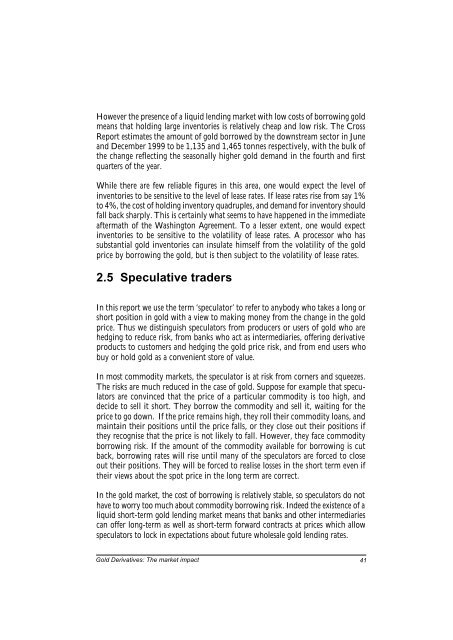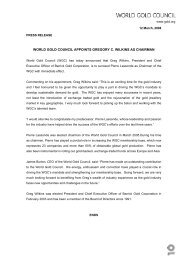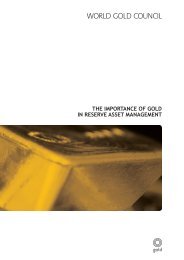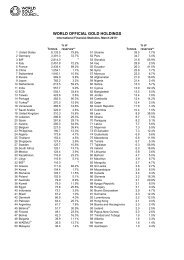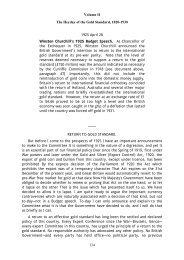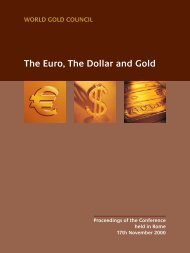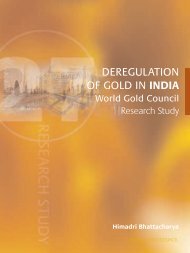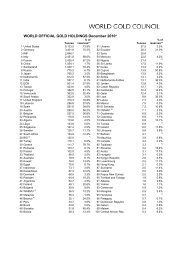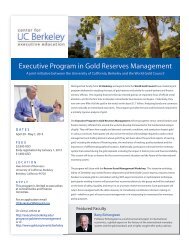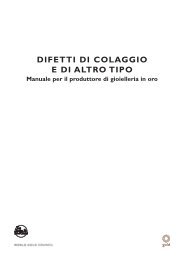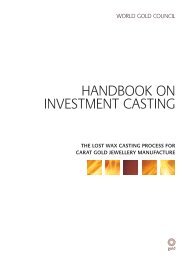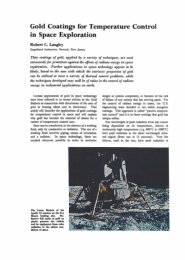Gold Derivatives: Gold Derivatives: - World Gold Council
Gold Derivatives: Gold Derivatives: - World Gold Council
Gold Derivatives: Gold Derivatives: - World Gold Council
You also want an ePaper? Increase the reach of your titles
YUMPU automatically turns print PDFs into web optimized ePapers that Google loves.
However the presence of a liquid lending market with low costs of borrowing gold<br />
means that holding large inventories is relatively cheap and low risk. The Cross<br />
Report estimates the amount of gold borrowed by the downstream sector in June<br />
and December 1999 to be 1,135 and 1,465 tonnes respectively, with the bulk of<br />
the change reflecting the seasonally higher gold demand in the fourth and first<br />
quarters of the year.<br />
While there are few reliable figures in this area, one would expect the level of<br />
inventories to be sensitive to the level of lease rates. If lease rates rise from say 1%<br />
to 4%, the cost of holding inventory quadruples, and demand for inventory should<br />
fall back sharply. This is certainly what seems to have happened in the immediate<br />
aftermath of the Washington Agreement. To a lesser extent, one would expect<br />
inventories to be sensitive to the volatility of lease rates. A processor who has<br />
substantial gold inventories can insulate himself from the volatility of the gold<br />
price by borrowing the gold, but is then subject to the volatility of lease rates.<br />
2.5 Speculative traders<br />
In this report we use the term ‘speculator’ to refer to anybody who takes a long or<br />
short position in gold with a view to making money from the change in the gold<br />
price. Thus we distinguish speculators from producers or users of gold who are<br />
hedging to reduce risk, from banks who act as intermediaries, offering derivative<br />
products to customers and hedging the gold price risk, and from end users who<br />
buy or hold gold as a convenient store of value.<br />
In most commodity markets, the speculator is at risk from corners and squeezes.<br />
The risks are much reduced in the case of gold. Suppose for example that speculators<br />
are convinced that the price of a particular commodity is too high, and<br />
decide to sell it short. They borrow the commodity and sell it, waiting for the<br />
price to go down. If the price remains high, they roll their commodity loans, and<br />
maintain their positions until the price falls, or they close out their positions if<br />
they recognise that the price is not likely to fall. However, they face commodity<br />
borrowing risk. If the amount of the commodity available for borrowing is cut<br />
back, borrowing rates will rise until many of the speculators are forced to close<br />
out their positions. They will be forced to realise losses in the short term even if<br />
their views about the spot price in the long term are correct.<br />
In the gold market, the cost of borrowing is relatively stable, so speculators do not<br />
have to worry too much about commodity borrowing risk. Indeed the existence of a<br />
liquid short-term gold lending market means that banks and other intermediaries<br />
can offer long-term as well as short-term forward contracts at prices which allow<br />
speculators to lock in expectations about future wholesale gold lending rates.<br />
<strong>Gold</strong> <strong>Derivatives</strong>: The market impact 41


